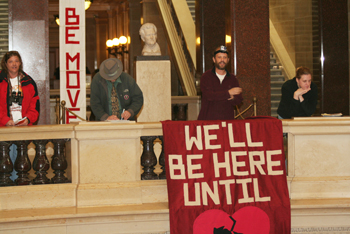 Jan. 29, 2015 – Wisconsin Capitol Police issued Michael Crute a citation for singing in the State Capitol without a permit. Recently, a state appeals court concluded that the rule requiring permits for sing-alongs is unconstitutional under the First Amendment.
Jan. 29, 2015 – Wisconsin Capitol Police issued Michael Crute a citation for singing in the State Capitol without a permit. Recently, a state appeals court concluded that the rule requiring permits for sing-alongs is unconstitutional under the First Amendment.
The Department of Administration issued the emergency rule, Wis. Admin. Code § Adm 2.14(2)(vm)5, in 2013 as a response to the “Solidarity Sing-Along,” a daily gathering of individuals who sang in opposition to legislation, mostly the legislature's action on collective bargaining.
The rule says that events in state-owned buildings and facilities may be declared unlawful if its participants “enter or occupy any building or facility managed or leased by the [DOA]" without a permit granting authorization. Violators of the rule were subject to a $500 fine.
The rule, on its face, required a permit even for groups of one individual. Small groups did not enjoy an exemption under the rule. The DOA could issue permits for events, but applicants had to complete a written application at least 72 hours in advance of the event.
Crute received a citation as a participant in the unauthorized sing-along in July 2013. He challenged the citation, arguing the permitting scheme was facially unconstitutional.
In State v. Crute, 2014AP659 (Jan. 29, 2015), a three-judge panel for the District IV Wisconsin Court of Appeals affirmed, concluding that the state did not prove beyond a reasonable doubt that the rule was a constitutional restriction on free speech.
First, the appeals court ruled that the state forfeited a right to argue that the rule did not implicate First Amendment rights, because it conceded that point in circuit court.
“[T]he State has forfeited both its argument that the circuit court improperly failed to require Crute to meet his initial burden of showing that the rule implicated the First Amendment, and its argument that Crute could not have met that burden because the rule implicated unprotected conduct only,” wrote Judge JoAnne Kloppenburg.
Second, the court ruled that the state did not meet its burden to prove the rule was constitutional, noting that it was not “narrowly tailored” to bigger groups of people.
The panel noted that government may restrict the time, place, and manner of speech in public forums, but restrictions must be content-neutral, narrowly tailored to serve a significant governmental interest, and must leave alternatives for communication.
The parties agreed that restrictions were content-neutral and left alternatives for communication. The parties also agreed that the DOA had a significant governmental interest in restricting and managing public space that hosts many planned activities.
But the parties disputed whether the rule was “narrowly tailored” to promote the government’s interest that would be achieved less efficiently absent the rule. The state said the court should read the rule as applying only to groups of more than 20 people.
The state had conceded that the rule is unconstitutional unless it does not apply to small groups. But the state said the circuit court erred by not reading into the rule a specific numerical floor that would render the rule constitutional. The panel disagreed.
The panel rejected the state’s claim that the rule left room for a “narrowing construction,” and prior case law – a federal case that prohibited enforcement of the same rule at issue here – allowed the court to read-in a numerical floor.
However, the panel explained that the federal case, Kissick v. Huebsch, “did not hold that the rule was amenable to a 21-person numerical floor construction so as to save it from a facial challenge,” so the state’s reliance on Kissick was misplaced.
Finally, the panel rejected the state’s claim that that the rule is constitutional because the DOA, in practice, actually imposed a 21-person numerical floor after Kissick.
“The State cites case law that sets out the general proposition that a court, in evaluating whether a regulation is narrowly tailored, may consider a narrowing construction that a government has given the challenged law,” Judge Kloppenburg explained.
The panel noted the Kissick court issued a temporary injunction that prohibited application of the rule against small groups under 21 persons, and the DOA was merely complying with the court’s order when it stopped requiring permits for small groups.
“[I]f the Kissick order had been lifted, there is no reason, based on the record before us, to believe that the Department would have continued to adhere to the 21-person numerical enforcement floor,” Judge Kloppenburg wrote.
